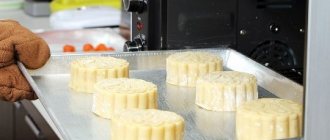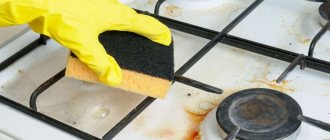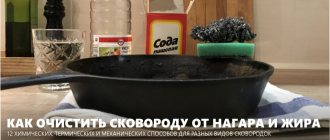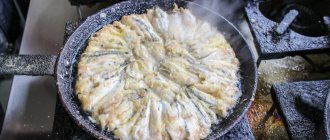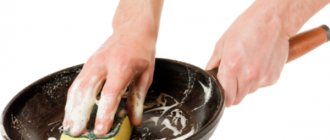The gas stove is rightfully considered one of the most quickly dirty and problematic kitchen surfaces. In addition to the handles and oven, caring for a gas stove is also complicated by the presence of a grate and burners, from which it is most difficult to remove clogged dirt such as grease, soot, and burnt sugar.
The question of choosing between folk remedies and household chemicals is individual for each housewife. Everything is decided by convenience and accessibility. Read more about ways to clean gas stoves in our material.
Folk remedies for fat and soot
Baking soda
The substance is diluted to a paste-like consistency, which requires ½ cup of soda and 3-5 tablespoons of water. The mixture is applied with the soft side of a sponge or a rag. It is better not to use soda ash, as it contains alkali, which can cause scratches.
Soap solution
Most often, 72% laundry soap is used. The third part of the bar is grated on a regular coarse grater and mixed with 5–7 liters of hot water. A substitute for laundry soap, but less effective, can be dishwashing detergent or washing powder.
Vinegar
Mixes with water in a 1:1 ratio. There are two options for use: spraying from a spray bottle or wetting a sponge in the prepared solution.
Ammonia
Similarly with vinegar, dilute with water 1:1. It is also recommended to use ammonia after the first treatment with soap or soda solution to remove old stains.
There are a number of substances and products whose properties also allow them to be used to remove dirt from gas stoves. Among them are ammonia, dry mustard, river sand, and lemon juice.
You need to be very careful when using abrasives and metal brushes, which can cause small scratches and cause faster contamination in the future. A hard sponge, for example, can be replaced with an old toothbrush.
Lemon acid
It is gentle on the surface of the stove, but harmful to fat.
Acid breaks down plaque and also has a good abrasive effect, which additionally removes dirt.
Necessary:
- Moisten the stain with a damp sponge.
- Apply a tablespoon of citric acid granules.
- Let stand for 3-5 minutes, then walk over the surface with the hard side of the sponge.
To increase abrasiveness, citric acid can be mixed with coarse table salt and the manipulation can be repeated.
Advantages:
- A safe method that does not cause irritation upon contact with exposed skin.
- Removes old stains well.
- Makes the surface glossy.
- Gives a pleasant lemon aroma.
Flaws:
- Not suitable for daily cleaning as it contains a high level of acidity.
Expert opinion
Borodina Galina Valerievna
If there is a lemon left in the refrigerator that will no longer be used for food, you can cut it into pieces and walk over the dirty surfaces of the stove. Light stains will quickly disappear even without a sponge, and the hob will get a shine.
How to clean the handles of a gas stove
There are different options for cleaning removable and non-removable handles. For removable ones the process is simpler. They are soaked in vinegar or soap solution for 1–2 hours.
Difficult to remove stains are removed using a sponge soaked in ammonia diluted with water. A more radical option is to immerse the handles in a solution with ammonia, placing it on the switched-on burner for 7-10 minutes. After the liquid has cooled, rinse the handles with running water.
For non-removable ones, you will need ammonia or vinegar solution sprayed onto the surface of the handles. After 5–10 minutes, wipe the surfaces with a clean, dry cloth. To clean the grooves and crevices on the handles, you can use a toothbrush, cotton swabs and toothpicks.
Features of cleansing
Before you start cleaning the stove, you must first find out what material its covering is made of. Depending on this, you need to purchase a suitable cleaning product. Maybe the stove is made of stainless steel or enameled metal.
For each of these materials you need to select the right care and cleaning products. Parts that are removed must also be cleaned of dirt. These are burners, handles, burners, grates.
Enameled surface
This type of slab is very common and is the most popular. This is due to the following advantages:
— durability;
— wear resistance;
— unpretentiousness;
— various shades and models;
- low cost;
- corrosion resistance.
Cleaning such a coating is not difficult, but has a number of features. For example, it may experience mechanical damage that will be impossible to remove. The service life of an enamel coating is shorter than that of a stainless steel coating.
To clean the enamel, you can use any kitchen surface care product.
It is only important not to use abrasive and aggressive substances, hard sponges and brushes. This is due to the fact that they can spoil the appearance of the product, after which dirt will stick to it even more strongly.
For such coatings, only one powdered composition can be used - baking soda, because it has a gentle effect without causing harm.
How to clean a stainless steel gas stove
The popularity of such slabs is no less than the previous ones, for which there are reasons, which include:
— wear resistance;
— unpretentiousness in care;
— elegance of appearance;
- stylish design;
— duration of operation;
- resistance to mechanical damage.
The disadvantage of this coating is that even the smallest water stain is visible on it. To keep it looking attractive and shiny, you should wipe it all the time. Enameled surfaces should not be cleaned with hard brushes or abrasives. When damage appears on it, the shine disappears.
Soft sponges and rags are suitable for cleaning a stainless steel stove; it is better to choose products in the form of a spray or gel. After cleaning, you need to thoroughly wipe the surface with a paper towel or clean cloth so that there are no streaks on it.
REFERENCE! Drops of water remaining on the surface can be removed using glass cleaner.
Preparation
Before cleaning the gas stove, you must first prepare the surface. There are some tips to follow:
- Turn off the gas supply, that is, close the valve on the pipe. With this you can avoid leakage.
- Wait until the surface of the stove cools completely. Cleaning should not begin while the stove is warm or hot, otherwise you may get burned or damage the equipment.
- Then you need to prepare cleaning products. It is not worth mixing several, because it is not known what the result will be.
- Protect yourself with gloves on your hands and your respiratory tract with a mask. Otherwise, there is a risk of chemical burns.
- Remove all utensils and removable structural parts from the surface of the stove. First you need to remove the grates, then the burners. It’s also better to unscrew the knobs that regulate the gas supply, because they should also be washed.
- Remove food residues that can be easily removed without the use of products.
- When carrying out general cleaning, you should move from top to bottom. First they clean the surface of the stove, then the handles, and lastly the oven is washed.
How to clean gas stove grates
First you need to remove large dirt (food debris, greasy deposits, carbon deposits). Most of the dirt accumulates in the corners and places where the grate touches the stove. The easiest way to remove them is with a scraper (plastic and wooden) or a metal brush. But such methods are only relevant for cast iron and steel gratings and are not suitable for enameled ones.
Treatment with soda solution
The entire surface of the grate is treated with a sponge, after which it is left for several hours. Next, grease and dirt are removed with a rag or sponge. If there are uncleaned areas, go over the cast iron or steel grate with a stiff sponge or wire brush.
with ammonia and the entire grate is treated. To achieve the desired effect and eliminate unpleasant odors, it is better to put the grill in a plastic bag and leave it in it for 2–3 hours. Later, it is washed with dishwashing detergent and grease and carbon deposits are removed with a sponge.
When using a soap solution, you will need a container of a size and shape suitable for the grill (basin, bucket, sink). The grate will have to soak for several hours, after which it will be washed and cleaned. This method is great for enameled and steel gratings.
A dishwasher for removing dirt is only suitable for enamel racks. As for cast iron, a long stay of the material in water is fraught with the appearance of rust.
The product for car engines will remove grease and carbon deposits, but you will have to tinker a lot with washing off the remaining chemicals from the surface of the grille.
Ammonia, in turn, is a fairly effective means of getting rid of traces of fat. To do this, pour a glass of the substance onto a baking sheet and place it in an oven preheated to 100 degrees for about half an hour or a little longer. The cooled baking sheet is cleaned with a sponge, detergent and water.
What materials and tools are needed for the job?
To ensure that the process of cleaning dirt and grease goes quickly and efficiently, it is recommended to prepare all the necessary tools and cleaning products. This list may be different, but, in general, it should include a number of mandatory items:
- a cleaning agent or solution, but it is not recommended to use abrasive pastes, which can cause damage to the enamel;
- soft brush or sponge;
- a rag, preferably lint-free;
- rubber gloves to prevent damage to the skin of your hands.
The use of gloves is mandatory to avoid any allergic skin reaction
Some may find that scrapers that can be used with induction hobs are suitable for a gas stove. But their use is allowed only in the most extreme cases, in order to prevent damage to the enamel coating, which will lead to the rapid appearance of rust.
It should be borne in mind that even the most advertised stove cleaning product will not lead to an immediate positive result. Each composition must be applied to the surface of the stain for a while, and only then begin cleaning.
Don’t think that using even the most expensive products will instantly remove dirt. You still have to apply the composition and let it sit for a while.
How to clean gas stove burners
The lids removed from the burners are soaked in a soapy solution, possibly together with the grate. The burners themselves should be removed and wiped with a damp cloth or sponge. You should make it a habit to check the burners every time you clean your stove.
It is important to ensure that the flow of gas is not obstructed by dirty deposits. If present, the holes and recesses should be cleaned. To do this, you can use wire, an unbent paper clip, or even a needle.
Cleaning the glass ceramic hob
Soap solution and special products (creams, pastes, sprays) are best suited for cleaning glass-ceramic stoves. In addition to the fact that they do a good job of cleaning, they create a kind of film and add shine. Apply the solution and remove dirt with a soft sponge or glass scraper, which should be positioned at an acute angle to the surface.
Soda should not be used, as it has abrasive properties, causing the surface to become covered with small scratches. This cleaning method can be left as a last resort if it is not possible to use other means. It is important not to let the baking soda dry, otherwise the coating will be damaged.
To make it easier to remove stains from the surface of the stove olive oil should be poured onto the area requiring cleaning and left for 20 minutes.
The vinegar solution also does a good job of removing dirt, but also disinfects the surface.
ammonia-based window cleaner Next, it is wiped with a microfiber cloth.
Precautionary measures
In the process of care, you can accidentally harm not only yourself, but also render your equipment unusable. For your own safety, take these measures:
- wear rubber gloves;
- Avoid contact with eyes;
- Keep out of the reach of children.
It is much easier to care for an enamel surface than a steel or stainless steel surface. Therefore, find out reliably how to clean a stainless steel stove so that it retains its appearance for a long time. On enamel surfaces, stains that are left by an abundance of soap and soda are not noticeable. Therefore, you need to use such preparations carefully when cleaning metal surfaces. Now you know the secret recipes of housewives on how to clean any dirt from a kitchen assistant.
Top 5 cleaning chemicals for grease and carbon deposits
Synergetic belongs to the middle price category, equipped with a dispenser for ease of use and economical consumption.
Sanita is a quick-acting alkali-based product, suitable for all surfaces, without a pungent odor, and perfectly removes dirt and greasy deposits.
“Oven Cleaner”, Amway is an effective product with a thick consistency, has a pungent odor, lasts a long time, and belongs to the high price segment.
Bagi, Shumanit is a liquid or powder product for various types of surfaces, easy to use, effective, affordable, and has a pungent odor.
Cif is a universal product for many surfaces, better suited for fresh dirt and removing old grease, has a pleasant smell, and has a quick cleaning effect.
All household chemicals are available in several forms: liquid, gel, spray or powder. Liquid cleaners, as a rule, are used more economically because they are diluted in small quantities in water.
With the help of a spray, fat is removed more easily from hard-to-reach places. Gels are available with or without abrasive to protect surfaces from scratches. Powders are intended for hard surfaces that can withstand abrasive substances.
Practical advice
In order not to bring the condition of the gas stove to a critical state and not waste time on major cleaning, it is important to follow preventive measures. They will help you avoid stubborn stains and protect the surface from burnt stains and grease:
- When preparing dishes that are prone to splattering of fat, use special foil covers. They already have slots for the burners and fit perfectly on the hob. At the end of cooking, the pad can be thrown away or used again.
- Try to always keep the stove in order. Fresh stains are much easier to clean than old ones. Even the next day it is already more difficult to deal with the pollution.
- Cover pots and pans with lids that stop splashes and prevent them from reaching the surface of the gas stove.
- Do not leave spilled liquid on the stove and hope it will evaporate on its own. As a rule, even clean water will leave behind streaks and yellow spots.
As you can see, cleaning a gas stove is not a difficult task, but it is painstaking. By following these simple tips, you will maintain the attractiveness of its appearance, and it will serve you for many more years.
How to clean the oven
Soda
A soda solution is applied to all internal surfaces, except heating elements. If in certain areas the mixture darkens and turns brown (from soot and grease), you need to treat them more carefully.
In this state, open the oven slightly and leave for 12 hours or overnight. After time, use a damp cloth to remove as much dirt as possible. If necessary, use a plastic scraper.
For areas with difficult-to-remove dirt, spray a vinegar solution , which reacts with baking soda to form a soft foam. Next, everything is wiped off from plaque and foam.
Lemon acid
If time is short, there is a faster way to clean your oven. It is turned on and heated to a maximum of 200 degrees. Pour water with citric acid dissolved in it (10-20 g) into a container suitable for high temperatures or onto a baking sheet.
Place the baking sheet or container in a preheated oven on the lower level and leave until the liquid boils. Next, turn off the oven and leave for 30 minutes, then wipe thoroughly.
Salt
The baking tray, where the salt is evenly scattered, is placed in an oven preheated to 100 degrees for half an hour. After cooling, the salt is scraped off with a plastic or silicone scraper, and the baking sheet is wiped with a damp cloth or sponge.
How to care for the hob
The hob itself and the lid of the gas stove need regular wiping with a damp sponge. If dirt cannot be removed, use a special detergent. For dried stains, not soft sponges, but mesh sponges are suitable.
You can use a saline solution (2 tbsp per 0.5 l of water). The liquid is applied to the stove, left for 10-12 hours and then wiped with a cloth and water.
How to avoid contamination:
- When cooking, monitor the flame so that it does not go beyond the bottom of the container.
- When boiling liquid should not fall on the gas stove burners.
- Wipe the hob with a sponge and water after each meal preparation.
- When baking in the oven, containers must be covered with special paper or foil.
Cleaning Sequence
Let's try to figure out how to clean a gas stove at home without extra costs and without harm. You need to choose the best product for yourself, prepare it yourself, and clean the gas stove. By testing, determine an effective method. There is no need to prepare a new composition every time. There is nothing more accessible and simpler than folk remedies for care. They are stored for several months in a cool, dark place.
The recipes listed may be modified depending on the availability of available materials at home. To effectively clean a gas stove, you need to follow the algorithm of actions. This is the only way to achieve the desired result.

